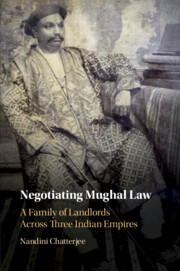Book contents
- Negotiating Mughal Law
- Negotiating Mughal Law
- Copyright page
- Contents
- Figures and Tables
- Maps
- Acknowledgements
- Note on Transliteration and Dates
- Abbreviations
- Introduction: Law in Many Forms
- 1 Malwa: Land of Many Empires
- 2 Zamīndārs: Lords of the Marches
- 3 Contractors: Engaging the State
- 4 Transactions: Recording Deals
- 5 Disputes: Judges and Courts
- 6 Invaders: Marathas and the British
- 7 Identity: Professionals or Warlords?
- Fragments to Archives: a Methodological Manifesto
- Appendix: A Catalogue of the P Das Archive
- Glossary
- Bibliography
- Index
- References
Bibliography
Published online by Cambridge University Press: 27 March 2020
- Negotiating Mughal Law
- Negotiating Mughal Law
- Copyright page
- Contents
- Figures and Tables
- Maps
- Acknowledgements
- Note on Transliteration and Dates
- Abbreviations
- Introduction: Law in Many Forms
- 1 Malwa: Land of Many Empires
- 2 Zamīndārs: Lords of the Marches
- 3 Contractors: Engaging the State
- 4 Transactions: Recording Deals
- 5 Disputes: Judges and Courts
- 6 Invaders: Marathas and the British
- 7 Identity: Professionals or Warlords?
- Fragments to Archives: a Methodological Manifesto
- Appendix: A Catalogue of the P Das Archive
- Glossary
- Bibliography
- Index
- References
Summary
- Type
- Chapter
- Information
- Negotiating Mughal LawA Family of Landlords across Three Indian Empires, pp. 269 - 290Publisher: Cambridge University PressPrint publication year: 2020
- Creative Commons
- This content is Open Access and distributed under the terms of the Creative Commons Attribution licence CC-BY-NC-ND 4.0 https://creativecommons.org/cclicenses/

